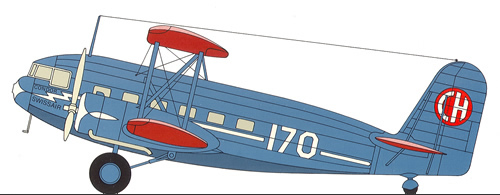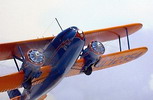1934
![]()
1934

![]()






![]()
A two-bay biplane of mixed construction, with a wire braced single fin and
rudder assembly and a the landing gear, with its main units retracting into
the engine nacelles. The T-32 prototype made its maiden flight on January 30,
1933. Layout for most of the production batch of 21 aircraft that followed was
as a luxury 12-passenger night sleeper airliner, and a number of T-32s flew
with Eastern Air Transport and American Airways during the following three years
of regular night service. Ten T-32 were ultimately converted to AT-32 standards
and these were designated T-32C. Swissair also operated one AT-32. It was the
first airliner in Europe to have a Stewardess, but sadly met a tragic end shortly
after beginning service in March of 1934, when it crashed killing all on board.
Many other variants of the T-32 existed. The AT-32 differed from the T-32 in
having variable-pitch propellers and full NACA cowling, in lieu to the T-32's
Townsend rings. The AT-32D was developed as a 15-passenger day airliner. Two
AT-32E aircraft were built for the US Navy and operated under the designation
R4C-1 by the Navy and Marines as 12-passenger deluxe transports. There was also
a Bomber Variant, the BT-32 and a Cargo Variant, CT-32.
![]()
Manufacturer |
Curtiss Aeroplane and Motors Company, Robertson (USA) |
| Span |
25.00 m |
Length |
14.96 m |
Height |
5.00 m |
Power
(HP) |
2 x 720 |
Cruising
Speed |
245 km/h |
Passengers |
15 |
Range |
800 km |
Area
of Operation |
Europe (Zurich-Stuttgart-Leipzig-Berlin Route) |
![]()
![]()
 |
|||||
![]()
![]()
![]() Please
make sure you read the disclaimer regarding copyrights etc.
Please
make sure you read the disclaimer regarding copyrights etc.